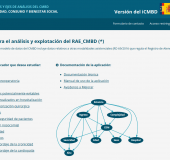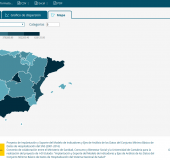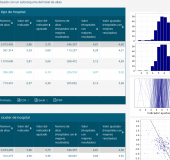iCMBD
iCMBD
The iCMBD project, promoted by the Ministry of Health, aimed to develop a model of analysis of the MBDS database that gives simple and reliable responses. Our platform enables the Ministry's technicians to do so in a structured fashion, covering the needs needs for tracking and evaluating the hospitalization healthcare quality on the Spanish National Health System.
This project, named "Model of indicators for the Hospitalization in the National Health System and analysis through a web, opened to professionals and citizens", received the second prize in the 7th edition of the Professor Barea awards, in the multi-partner projects category.
Key features
Description
An analysis model for the MBDS was defined on the framework of the project that allows to detect interesting information in order to study treated case mix, its behaviour, and the different healthcare profiles that appear in the hospitalization process. This model has essential components that facilitate the knowledge of the case mix of the hospitalization records present in the national MBDS:
- Dimensions: General objectives of knowledge
- Analysis axis: Dimensional analysis lines
- Indicators: Processed data that inform about concrete facts of one or more dimensions
- Classification levels: Recommended terms for indicator elaboration, in a way that allows aggregation a disaggregation
- Filters: Selection conditions that restrict indicator calculus to a sample of the records universe. Selection can involve one or more variables
There are seven dimensions for analysis:
- Descriptive: frequency distribution for incidence analysis that facilitate the description of the series
- Attendance: usage rate for spontaneous demand or suggested by a medial professional of the population of health center admissions
- Average resoluteness in: assistance duration and contact number
- Clinical practice styles through studies that assess the variability level
- Patient security: bad practice or avoidable through prevention effects
- Clinical effectiveness: health restoring without side effects
- Efficiency: Performance with resources in health assistance.
- Point cut: Descriptive
- Temporal series: Descriptive of one year with relative differences with a three year period.
- Base value: Comparatives with a year selected as the base value.
- Standard intra-series: Comparatives with the mean value of the series' totals.
- Best practices: Using hospital groups, compares values from the whole dataset with values below the 25-percentile of the series.
- Adjustment lines: Recommended as complementary analysis axis according to previously identified variables for each indicator.
Consult the project documentation for more information: documentation
This project, named "Model of indicators for the Hospitalization in the National Health System and analysis through a web, opened to professionals and citizens", received the second prize in the 7th edition of the Professor Barea awards, in the multi-partner projects category.
Web application
One of the project results was a web site opened to the citizens in which the healthcare quality indicators can be interactively consulted using the described analysis axis. The application analyses over 40 million records and several tens of indicators, performing calculations in real time.
Between the functionalities stands out a new methodology of indicator adjustment based on Bayesian Networks developed by the Data Mining Group of the University of Cantabria:
Risk analysis methodology (sometimes named severity or case-mix adjustment) is a fundamental part in healthcare quality assessment and is used routinely in several national and international projects of service providers quality (ranking, budget assignment, etc.). For example, the AHRQ publishes its quality indicators along with generic risk adjustment results. However you can't avoid all the variability and further analysis is needed for a practical concrete problem, like budget assignment.
The most used adjustment methodology found in literature is based in logistic regressions with the fundamental limitation of only being able to reproduce monotonous relationships between the adjustment factors and the adjusted indicator. The proposed methodology based on Bayesian Networks overcomes this limitation being the ideal technique for modelization indicators depending on discrete variables:
When factors are discrete, Bayesian Networks are the most efficient solution for building probabilist models of all the variables, allowing to estimate the probability of the indicator from the kown risk factors: P(yk ,x1k ,xnk). In this case, the Bayesian Network offers an alternative more efficient for adjust the the indicator using the different profiles and its probabilities.
More information can be found in the project documentation: indicator's adjustment methodology
Our contribution
Since the year 2009, we have participated in several phases of the project. Our contribution has been focused on:
- Evolutionary development of the indicator analysis application: an application developed in Java using frameworks like Struts, Spring e Ibatis between others.
- Development of a data flow system for new data ingestion and indicator calculation: an ETL system developed in Java capable of managing the high data volumes involved in the project.
- Evolutionary development of the statistical indicator adjustment model model based on Bayesian Networks.




